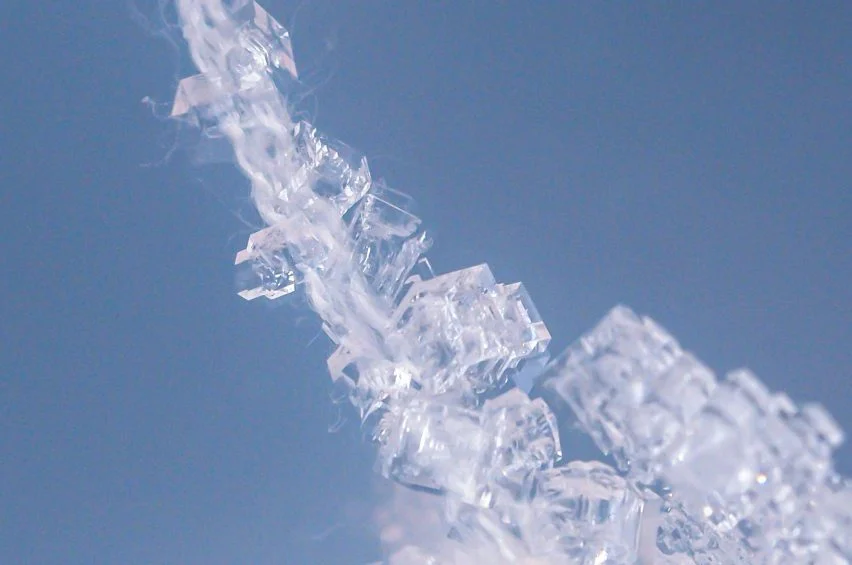The Telegraph looks at a newly-created material from a very natural material – and the designer behind much of the creativity:
This fascinating new material could be the future of sustainable luxury
Beginning with humble seasalt, a forward-thinking designer has created a material as impressive as marble at a fraction of the weight…
Like marble, but lighter: the fascinating new material is the future of sustainable luxury [paywall]
She makes beautiful objects, as explored by the FT:
How salt interiors became flavour of the month
Designers are going wild for sodium chloride
French designer Roxane Lahidji uses salt in many of her creations: “We now have freezers; global warming means we use less salt to de-ice roads; and rising sea waters mean that salt is becoming more abundant.” Her work with design research program Atelier Luma has been to find “different design applications for it”. Lahidji makes sculptural furniture, including striking milky-white marmoreal side, console and occasional tables, using salt harvested from marshes in the Rhône delta. “It has such strong parallels with marble,” she says, adding: “The fact that I have taken something fluid from the sea and transformed it into something solid and rock-like, I find quite poetic.”
How salt interiors became flavour of the month | Financial Times
But this goes beyond beautiful objects, as the FT also looks at the promises, and problems, of this natural material:
Saline solutions: creatives use salt waste to make furniture and sculpture
As they show the potential of the abundant material, designers are also raising awareness of its environmental impact
French designer Roxane Lahidji uses salt from man-made marshes in the Rhône delta to create tables and seating with a marble-like pattern. She mixes a composite of 90 per cent sea salt and natural binders and pigments, which she moulds and air dries, before coating with an eco epoxy resin...
Sodium chloride is a life-supporting mineral with many virtues: it is antibacterial, antiviral and highly fire resistant, thanks to its melting point of around 800C.
Henna Burney, a designer at the design and research laboratory Atelier Luma in Arles, France, believes that salt is a material of the future. “Its abundance means we can think big,” she says. “We could even build homes with it one day.” Burney has spent five years researching its uses, collaborating with salt farmers and designers including Lahidji. The team has compressed it into antiviral door handles and grown 4,000 crystallised interior cladding panels on metal meshes for a tower at Frank Gehry’s Luma Arles arts complex.
But salt’s virtues come with challenges: it is prone to moisture absorption and erosion by wind and water, and it can corrode metal. Crystallisation is also tricky to predict. “It’s a spontaneous process that can easily go wrong,” Burney says. “If you leave the substrate in the water one day too long, the crystals might be too big, or if it rains they could dissolve.”
Saline solutions: creatives use salt waste to make furniture and sculpture | Financial Times
Finally, another French designer from the Atelier Luma looks at the ‘material of the future’:
Henna Burney extols “extraordinary potential” of salt
Day 10 of the Dezeen 15 virtual festival saw material designer Henna Burney of Atelier Luma divulge the potential of salt as a material for the future in a live video interview. “The future will be built with materials that are both new and old,” Burney states in her manifesto written for Dezeen 15. “Salt is a material of the future: an essential life-supporting mineral, ancient in its uses and abundant as a resource.”
However, she believes designers are currently failing to take notice of abundant natural resources such as salt in the quest for new materials. “Natural but overlooked materials such as salt have extraordinary potential,” Burney explains. “We only need to look around with fresh eyes, rediscover lost knowledge and chart new ways of thinking about materials and their ecosystems.”
Alongside her manifesto, today Burney is also showcasing cladding panels that she made using salt as well as new software that could help other designers make use of the material. Henna Burney is a material designer based at the design and research laboratory, Atelier Luma, in Arles, France. She specialises in developing new types of biomaterials.
Henna Burney extols “extraordinary potential” of salt
Here is her ‘manifesto for salt’:

“Salt is a material of the future” says Henna Burney of Atelier Luma
…
